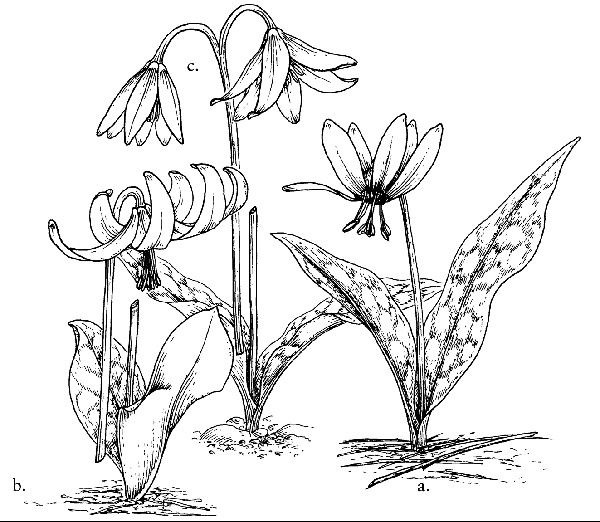About 20 species of bulbous plants from the northern temperate zone, but mainly North America with the bulk of species occurring on the West Coast. The bulb is an asymmetrical, elongated cone with a basal plate situated at the side, somewhat resembling a dog's tooth. Each bulb produces a pair of basal leaves which may be shiny green, glaucous green or marbled in shades of brown, this varying from intense to faint even within one species. The solitary, simple or branched flowering stem bears one to several pendulous, hanging bells formed of six tepals (in two whorls of three) which may recurve or reflex on warm sunny days. The base of the petals may have auricles or raised swellings on the inside which support the anther filaments and these may be median (in the middle) or lateral (at the edges) of each tepal. Their presence and type is a valuable diagnostic feature. Flower colour ranges through pink, purple, yellow or white, the throat usually a contrasting colour; in some forms a brown ring is present.
All species appear to be hardy and are suitable for the rock garden. The yellow hybrids and White Beauty, are robust enough for general use, but most other species are better if grown in light, dappled or occasional shade. All benefit from humidity and wind-shelter. Soil should be humusy, moisture retentive but well-drained. Wet soils, especially winter-wet soils, are unsuitable. Heavy clay should be conditioned with leafmould. None of the species show a preference for lime or acid soils in cultivation: some are restricted to areas of serpentine rock in the wild. Planting time is from June to October, later if the bulbs have been kept moist (although root damage is likely if left too late). The lack of bulb tunic means that they dry out rapidly and bulbs which are not firm, or have blue mould should be rejected. Propagation by removal of naturally produced offsets when the plants are dormant. Most species seem to resent physical division of interconnected bulbs, especially the E. dens-canis complex. Not all species make offsets. Seed should be sown whilst fresh and will germinate in spring, needing three to four growing seasons to reach flowering size.

a, E. dens-canis; b, E. hendersonii; c, E. revolutum;
Sign up for our newsletter to receive our monthly update direct to your inbox. Featuring our latest articles and news.
Built by Atomic Smash

